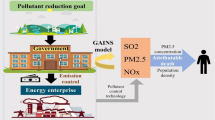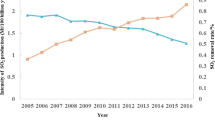Abstract
The Chinese government has explicitly promised to peak carbon dioxide emissions by 2030 and strive to become carbon neutral by 2060. As the capital of China, Beijing should play a pilot role in reducing carbon emissions. Researching on the synergistic effect of air pollutants and carbon dioxide emissions reduction can be conducive to the reduction of carbon and pollution, and ultimately promote economic growth and enhance environmental management. Based on the extended Kaya identity and the gray correlation model, this study analyzes the correlation degree of the influencing factors of collaborative emission reduction. The Logarithmic Mean Divisia Index method (LMDI model) is conducted to decompose the driving effects and quantify the collaborative emission reduction effects of main air pollutants and carbon dioxide in Beijing. The results showed a strong correlation (correlation coefficient > 0.6) between carbon dioxide and major air pollution. The energy intensity and energy structure are the main factors to promote the major air pollutants emission reduction in Beijing, while the economic output and population size increase the air pollutant emissions. The average CO2 contribution rate to SO2, NOx, and PM10 from 2010 to 2019 was 9.60, 5.99 and 9.06%, respectively. In general, there is a significant connection between CO2 emissions and the main air pollutants. However, the synergistic emission reduction effect of CO2 and SO2 is greater than that of CO2 and NOx, and CO2 and PM10. Finally, this paper proposes several countermeasures and suggestions for front-end prevention, middle-end control, and collaborative emission reduction based on the findings.
Graphical abstract






Similar content being viewed by others
Data Availability
The authors declare that all data and materials used or analyzed during the current study are available from the corresponding author on reasonable request.
References
Acaroğlu H, Güllü M (2022) Climate change caused by renewable and non-renewable energy consumption and economic growth: a time series ARDL analysis for Turkey. Renewable Energy 193:434–447. https://doi.org/10.1016/j.renene.2022.04.138
Alimujiang A, Jiang P (2020) Synergy and co-benefits of reducing CO2 and air pollutant emissions by promoting electric vehicles—a case of Shanghai. Energy Sustain Dev 55:181–189. https://doi.org/10.1016/j.esd.2020.02.005
Ang BW (2015) LMDI decomposition approach: a guide for implementation. Energy Policy 86:233–238. https://doi.org/10.1016/j.enpol.2015.07.007
Aydin G (2014) Modeling of energy consumption based on economic and demographic factors: the case of Turkey with projections. Renew Sustain Energy Rev 35:382–389. https://doi.org/10.1016/j.rser.2014.04.004
Aydin G, Jang H, Topal E (2016) Energy consumption modeling using artificial neural networks: the case of the world’s highest consumers. Energy Sources Part B 11:212–219
Bertoldi P (2022) Policies for energy conservation and sufficiency: review of existing policies and recommendations for new and effective policies in OECD countries. Energy Buildings 264:112075. https://doi.org/10.1016/j.enbuild.2022.112075
Chae Y (2010) Co-benefit analysis of an air quality management plan and greenhouse gas reduction strategies in the Seoul metropolitan area. Environ Sci Policy 13:205–216. https://doi.org/10.1016/j.envsci.2010.01.003
Chae Y, Park J (2011) Quantifying costs and benefits of integrated environmental strategies of air quality management and greenhouse gas reduction in the Seoul Metropolitan Area. Energy Policy 39:5296–5308. https://doi.org/10.1016/j.enpol.2011.05.034
Chai N, Zhao T, Lin T (2012) Grey relation analysis of carbon dioxide emissions from energy consumption of industries in China. Ecological Economy 09:105–107
Chan CK, Yao XH (2008) Air pollution in mega cities in China. Atmos Environ 42:1–42. https://doi.org/10.1016/j.atmosenv.2007.09.003
Chen J, Li J, Xiong WX, Xing C, Yu H, Shi Y (2022) Analysis of typical NOx pollution processes and sources in Wuhan City. Environ Sci Technol 45:140–147
Dai XW, He YQ, Zhong QB (2015) Driving factors and their contributions to agricultural CO2 emission due to energy consumption in China: based on an expended Kaya identity and LMDI decomposition method. Chin J Eco-Agric 23:1445–1454
Deng JL (2002) Grey theoretical basis. Huazhong University of Science & Technology Press, Wuhan
Ding L, Diao BD (2021) Industrial air pollutants emission and social influencing factors in Zhejiang from the perspective of spatial econometrics. Environ Pollut Cont 43:132–138
Du HB, Zhao LJ, Liu CW, Qiu KB, Li HD (2022) Prediction of peaking carbon dioxide emissions in main city Areas based on LEAP model and KAYA model and analyses on its uncertainty. J Ecol Rural Environ 38:983–991
Eskander SMSU, Nitschke J (2021) Energy use and CO2 emissions in the UK universities: an extended kaya identity analysis. J Clean Prod 309:127199. https://doi.org/10.1016/j.jclepro.2021.127199
Gao YB, Xing YK, He F, Kuai P, Mao XQ (2021) Research on co-control effectiveness evaluation of energy saving and emission reduction measures in China’s iron and steel industry. Clim Change Res 17:388–399
IPCC (2006) Green gas inventory: IPCC guidelines for national greenhouse gas inventories. United Kingdom Meteorological Office, Bracknell
Jiang P, Khishgee S, Alimujiang A, Dong HJ (2020a) Cost-effective approaches for reducing carbon and air pollution emissions in the power industry in China. J Environ Manag 264:110452. https://doi.org/10.1016/j.jenvman.2020.110452
Jiang S, Zhu YN, He GH, Wang QM, Lu YJ (2020b) Factors influencing China’s non-residential power consumption: estimation using the Kaya–LMDI methods. Energy 201:117719. https://doi.org/10.1016/j.energy.2020.117719
Jiao JD, Huang Y, Liao CP (2020) Co-benefits of reducing CO2 and air pollutant emissions in the Urban transport sector: a case of Guangzhou. Energy Sustain Dev 59:131–143. https://doi.org/10.1016/j.esd.2020.10.005
Kaya Y (1989) Impact of carbon dioxide emission on GNP growth: interrelation of proposed scenarios. In: Paris: Presentation to the energy and industry subgroup, response strategies working group, IPCC pp 1–25
Li LY (2016) Analysis of constraint of atmospheric pollutants emission reduction on China’s coal consumption. Coal Econ Res 36:24–27
Li K, Ma MD, Xiang XW, Feng W, Ma ZL, Cai WG, Ma X (2022) Carbon reduction in commercial building operations: a provincial retrospection in China. Appl Energy 306:118098. https://doi.org/10.1016/j.apenergy.2021.118098
Lin D, Zhang L, Chen C, Lin YY, Wang JK, Qiu RZ, Hu XS (2019) Understanding driving patterns of carbon emissions from the transport sector in China: evidence from an analysis of panel models. Clean Techn Environ Policy 21:1307–1322. https://doi.org/10.1007/s10098-019-01707-y
Liu HM, Fang CL, Huang JJ, Zhu XD, Zhou Y, Wang ZB, Zhang Q (2018) The spatial-temporal characteristics and influencing factors of air pollution in Beijing-Tianjin-Hebei urban agglomeration. Acta Geographica Sinia 73:177–191
Lv C, Li YX, Yang N, Liu H, Liu ZL (2020) Assessment and scenario analysis of on road vehicle greenhouse gases emission: a case study of Beijing. Environ Eng 38:25–32
Ma MD, Cai W, Cai WG (2018) Carbon abatement in China’s commercial building sector: a bottom-up measurement model based on Kaya-LMDI methods. Energy 165:350–368. https://doi.org/10.1016/j.energy.2018.09.070
Pan L, Sun BS, Wang W (2011) City air quality forecasting and impact factors analysis based on grey model. Proc Eng 12:74–79. https://doi.org/10.1016/j.proeng.2011.05.013
Peduzzi E, Baldi MG, Pisoni E, Kona A, Bertoldi P, Monforti-Ferrario F (2020) Impacts of a climate change initiative on air pollutant emissions: insights from the Covenant of Mayors. Environ Int 145:106029. https://doi.org/10.1016/j.envint.2020.106029
Pei XD, Wu J, Xue JB (2021) Analysis on the influencing factors of SO2 emission in China’s provincial industry based on LMDI and hierarchical clustering. Ecol Econ 37:183–189
RIVE N (2010) Climate policy in Western Europe and avoided costs of air pollution control. Econ Model 27:103–115. https://doi.org/10.1016/j.econmod.2009.07.025
Shan YL, Huang Q, Guan DB, Hubacek K (2020) China CO2 emission accounts 2016–2017. Sci Data 7:54. https://doi.org/10.1038/s41597-020-0393-y
Tang W, Zheng SW, He P, Xu HL, Gu Y, Yan LL, Yang Q, Huang C, Shen Y (2019) Study on the co-benefit of motor vehicle emission control based on scenario analysis in Hangzhou. Acta Sci Circum 39:2033–2042
Wang D, Shen Y, Nie R, Zhao YY (2019a) Regional differences in urban air pollution and its reduction pathways—evidence from industrial SO2 emissions in Anhui Province. J Saf Environ 19:1367–1374
Wang KL, Miao Z, Zhao MS, Miao CL, Wang QW (2019b) China’s provincial total-factor air pollution emission efficiency evaluation, dynamic evolution and influencing factors. Ecol Ind 107:105578. https://doi.org/10.1016/j.ecolind.2019.105578
Wang LK, Wang Y, He H, Lu YL, Zhou ZH (2020) Driving force analysis of the nitrogen oxides intensity related to electricity sector in China based on the LMDI method. J Clean Prod 242:88–102. https://doi.org/10.1016/j.jclepro.2019.118364
Wen Y, Ma Z, Wu YH, Zhou K, Shi L, Wang M (2018) Factors decomposition of industrial air pollutant emissions in Beijing-Tianjin-Hebei region and surrounding areas based on LMDI model analysis. China Environ Sci 38:4730–4736
Wu HH, Liu SF, Du JL, Fang ZG (2022) A novel grey spatial extension relational model and its application to identify the drivers for ambient air quality in Shandong Province, China. Sci Total Environ 845:157208. https://doi.org/10.1016/j.scitotenv.2022.157208
Xia HH, Ding L, Zeng KF, Liu C (2017) Atmospheric pollution effects in the process of industrial development of the Yangtze River Economic Belt during 1996–2013. Resour Environ Yangtze Basin 26:1057–1067
Xiang XW, Ma MD, Ma X, Chen LM, Cai WG, Feng W, Ma ZL (2022) Historical decarbonization of global commercial building operations in the 21st century. Appl Energy 322:119401. https://doi.org/10.1016/j.apenergy.2022.119401
Xue CJ, Fang ZQ (2022) Path of peak carbon dioxide emissions and carbon neutrality in soil remediation industry. Environ Eng 06:1–10
Yan X, Sun SH (2021) Impact of electric vehicle development on China’s energy consumption and greenhouse gas emissions. Clean Techn Environ Policy 23:2909–2925. https://doi.org/10.1007/s10098-021-02209-6
Yan R, Xiang XW, Cai WG, Ma MD (2022) Decarbonizing residential buildings in the developing world: historical cases from China. Sci Total Environ 847:157679. https://doi.org/10.1016/j.scitotenv.2022.157679
Yang JZ, Zhao Y, Cao J, Nielsen CP (2021a) Co-benefits of carbon and pollution control policies on air quality and health till 2030 in China. Environ Int 152:106482. https://doi.org/10.1016/j.envint.2021.106482
Yang X, Meng CY, Lin JL, Wang JH (2021b) Study on the Spatiotemporal evolution of carbon emissions and the regional heterogeneity influences of the four functional areas under Beijing non-capital functions relocation policy. J China Univ Geosci 21:77–90
Zang ZF, Zhang FY, Li YH, Xing Y (2021) Spatio-temporal distribution and affecting factors of PM2.5 and PM10 in major grain producing areas in China: a case study of Henan province. J Nat Resour 36:1163–1175
Zhang XB, Yu B (2020) Grey correlation analysis of PM2.5 in Beijing based on social factors. Environ Prot 48:60–66
Zhang SF, Ma MD, Xiang XW, Cai WG, Feng W, Ma ZL (2022) Potential to decarbonize the commercial building operation of the top two emitters by 2060. Resour, Conserv Recycling 185:106481. https://doi.org/10.1016/j.resconrec.2022.106481
Zhong L, Wang HM (2019) Research on Beijing’s carbon emission peaking as soon as possible and its future path. Energy China 41:42–47
Funding
This research was supported by Key Project of Beijing Social Science Foundation of China (19YJA002), Post-funded Project of National Social Science Foundation of China (21FJYB023), Key Project of Beijing University of Technology for Major Strategic Decision-making Consultation in the Capital in 2022 (011000514122545).
Author information
Authors and Affiliations
Contributions
All authors contributed to the study conception and design. Material preparation, data collection and analysis were performed by YL, JD and HZ. All authors commented on previous versions of the manuscript. All authors read and approved the final manuscript.
Corresponding author
Ethics declarations
Conflict of Interest
All authors declare that they have no conflict of interest.
Additional information
Publisher's Note
Springer Nature remains neutral with regard to jurisdictional claims in published maps and institutional affiliations.
Rights and permissions
Springer Nature or its licensor (e.g. a society or other partner) holds exclusive rights to this article under a publishing agreement with the author(s) or other rightsholder(s); author self-archiving of the accepted manuscript version of this article is solely governed by the terms of such publishing agreement and applicable law.
About this article
Cite this article
Li, Y., Dai, J. & Zhao, H. Analysis of collaborative emission reduction of air pollutants and greenhouse gases under carbon neutrality target: a case study of Beijing, China. Clean Techn Environ Policy (2023). https://doi.org/10.1007/s10098-023-02524-0
Received:
Accepted:
Published:
DOI: https://doi.org/10.1007/s10098-023-02524-0




